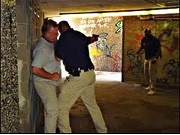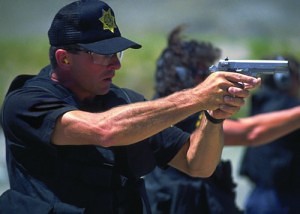Written by Benjamin Kurata
 When we talk about using firearms against lethal force threats, there is only one real measure of proficiency and an endless number of pseudo measurements. I do not say that in a negative way, as pseudo measurements save a lot of wear and tear on our personnel. However, we have to remember not to substitute the pseudo measurements for the real measurement.
When we talk about using firearms against lethal force threats, there is only one real measure of proficiency and an endless number of pseudo measurements. I do not say that in a negative way, as pseudo measurements save a lot of wear and tear on our personnel. However, we have to remember not to substitute the pseudo measurements for the real measurement.
The only real measurement of firearms proficiency in the realm of engaging and stopping lethal force threats is this: Did the officer / operator win the fight, and the threat(s) to the officer / operator lose the fight? Sub measurements of proficiency that fall under this can include:
- Number of rounds fired / hits on threat(s);
- Number of rounds fired by threat(s) / hits on officer / operator;
- Unintentional hits on non-involved bystanders;
- Unintentional hits on property (cars, houses, storefronts, etc.)
Any other measurement is a pseudo measurement. Within this broad area of pseudo measurements, some come closer to simulating actual fighting conditions and some have very little to do with actual fighting conditions. These include:
- Qualification courses;
- “Tactical” courses of fire;
- Formal competition;
- Etc.
 Please note that I do not see any of the above as a negative. Any time you are pressing trigger and getting hits on target you are reinforcing fundamental skills, and that is a good thing.
Please note that I do not see any of the above as a negative. Any time you are pressing trigger and getting hits on target you are reinforcing fundamental skills, and that is a good thing.
In my opinion, the most accurate, predictive live fire activity that the officer / operator can engage in short of an actual gunfight is force-on-force scenarios using dye marking cartridges and converted service weapons. Here, the hit ratio is very close to the actual hit ratio in gun fights. However, force-on-force scenarios have to be carefully scripted and controlled or they quickly degenerate into very expensive paintball games. An integral part of a well scripted scenario includes specific behavioral performance measurements that the trainer can document while the scenario is in progress.
We are all creatures of (1) comfort, (2) habit. We tend to do what is comfortable to us and avoid what is uncomfortable. If we receive enough positive feedback while performing what is comfortable to us, it becomes ingrained or a habit.
The same is true with shooting. We tend to rise to our individual level of comfort and then rationalize our level of performance. (“That’s close / good enough.”) We choose and repeat goals that we know we can routinely achieve.
(Author’s Note: I started this article in 2000, but shelved it because nobody in my organization at that time was interested in discussing proficiency. Recently, a nationally published writer called and asked us about proficiency levels and evaluation, so it might be a good time to visit this subject again.)
(This article continues in next week’s newsletter)
*Note: Action Target has recently been offering firearm training manuals for sale at our online store. We only charge the cost to produce and ship the item. There are no hidden fees. We believe that your safety is that important, so we elect not to capitalize on the manuals. To get your own hard copies of these training manuals, please click here.






